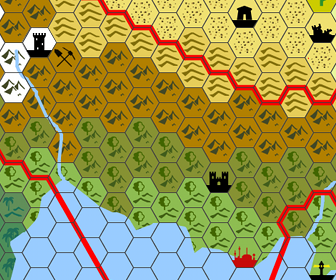It seems that people are having problems with the rules for Shaken in Savage Worlds. There are topics upon topics about this small rule. Many see it as a burden, and even stun-lock for your character. I disagree. I think that Shaken can be fun. And I plan to show you how [cue the music].
Shaken, not Stirred
Shaken may seem fiddly at first, but once you get a hang of it, you'll have no problem using it in more creative and/or narrative ways. First let's look at the mechanical bits of Shaken - so we know we are on the same page.
A character can get Shaken in various ways - Tests of Will, Fear, and, most commonly, damage. Once Shaken, their Pace is halved and they can't take any "actions". On their turn, they make a Spirit test to snap out of being Shaken - or they can simply spend a Bennie to do so.
When you are Shaken, you are easier to wound - if an attack makes you Shaken again, treat this roll as a Success with a Raise - in-depth explanation here). If you got wounded, you are also Shaken.
Those are all the crunchy bits of being Shaken, what follows, is a set of points helping you look at Shaken in a different, more narrative, light.
What it means to be Shaken?
Shaken is not a stun-lock. Nor it is just a status that appears over their head. The character doesn't just stand there. Something happened to the character to make them shaken. Ask yourself - what was it? Maybe the bullet scratching their arm made them panic? They grab their arm and dash for cover. Maybe the fire spell missed them, but set their sleeve on fire? Maybe they simply had the air kicked out of them? Or maybe they just froze in fear?
Savage Worlds is a cinematic system, so look at Shaken with movie logic. How many times you have seen an action flick where the main guy gets shot in the arm, and the only effect it had on the plot is that he sat down, grabbed his wound and maybe mumbled a few curse words. That's Shaken right there! Watch some action movies and try to identify "Shaken status" for the characters - you'l be surprised how varied Shaken can be.
Don't be afraid to narrate what is happening to the character who just got Shaken. Don't have an idea? Ask the player what happened to him, that shook him. Make the shaken more than just a status.
I'm Shaken, now what?
Shaken character can't do much else, than moving at their puny half-Pace - that's no fun. The way I see this rule, is that the character can't do anything that requires their full attention...or a roll.
On the character's turn, I don't simply tell them to roll their Spirit - I explain how Shaken is is affecting them (your sleeve is still on fire, you are gasping for air, your vision is blurry and everything spins, etc.) and ask them what are they doing. They can do anything, that would be considered a free action - yell few commands, ask for help, drop down - even try to put down their flaming sleeve (they succeed when their Spirit roll succeeds). As long as it requires no extra roll, it's viable. Now, ask them how they try to compose themselves and let them roll the Spirit (or give you a Bennie). Don't just skip their turn. Even if they are limited in their option, Shaken players can still do stuff.
As a Shaken player - don't waste your turn on a simple roll, make sure you do something! Think of all the ways you can impact the scene, without rolling the dice. It is a good improv and roleplaying exercise.
Stirring it up?
This approach may not be strictly by-the-rules and some people might be against it. If you are that kind of gamer remember this: Savage Worlds is not a game about balance - it is about cinematic action! Making people skip their turn entirely is an opposite of action and simply lacks fun.
GMs - let your Shaken players come up with cool, small actions that do not require a roll. Give them a Bennie for something that surprised you, or was a cool idea. They deserve it! And make being Shaken fun - narrate it!
Players - Shaken is a roleplaying opportunity - use it! Yeah, you can't roll on any tests apart from the Spirit one, but you can talk, yell and walk. This is a lot! And your GM will probably reward you with a Bennie for your wicked roleplaying skills. Worst comes to worst, you can use it to remove the shaken condition, eh?












